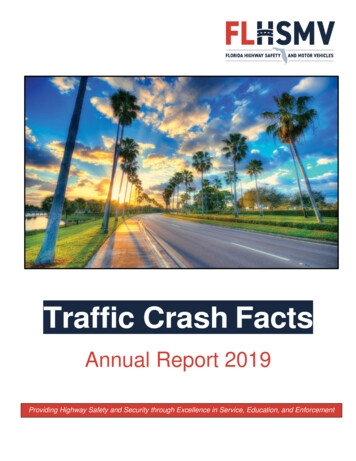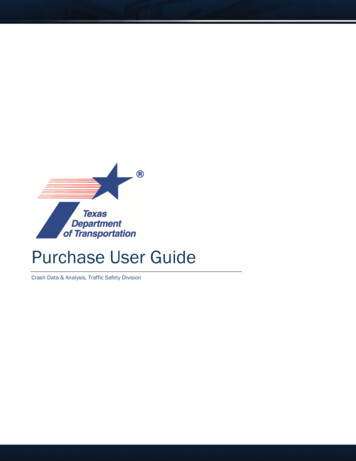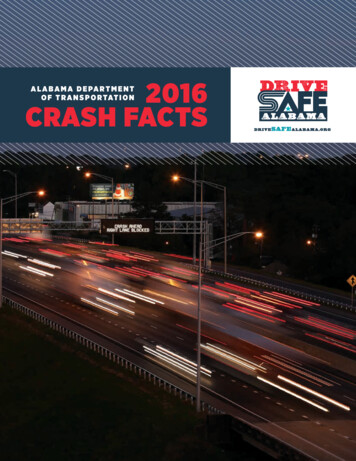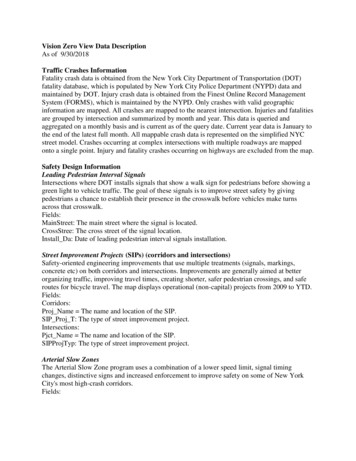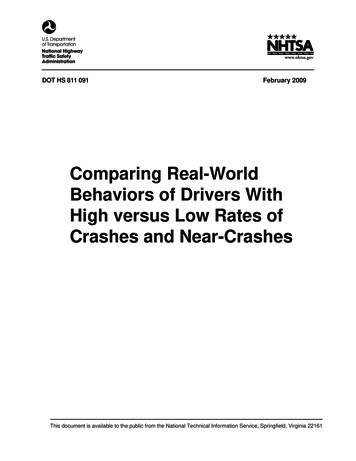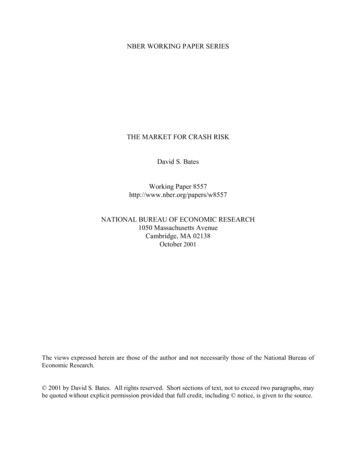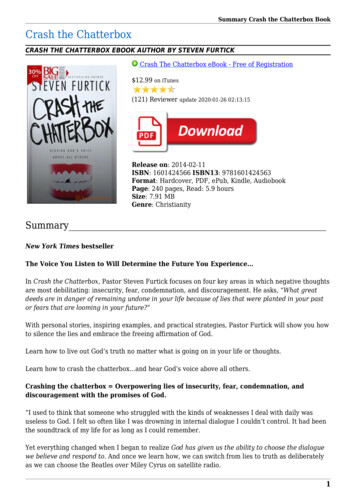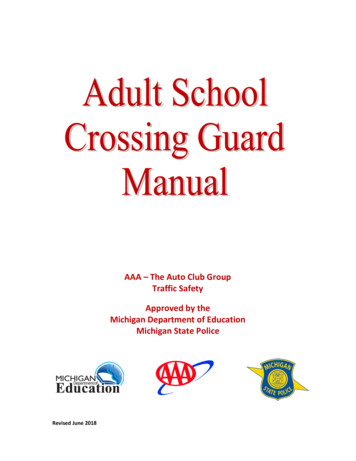
Transcription
MTCFMichigan TrafficCrash FactsFACT SHEETS2016
This page left intentionally blank
MTCFMichigan TrafficCrash Facts2016GENERAL FACTSThe driver, the roadway, and the motor vehicle contribute in some measureto every crash. A preponderance of evidence, however, points to driver erroras a chief cause in the majority of crashes.There were 312,172 crashes, of which 980 (0.3%) were fatal, 57,964(18.6%) were personal injury, and 253,228 (81.1%) were propertydamage only. Compared to 2015 this is a 5.1 percent increase in totalcrashes, an increase of 9.7 percent in fatal crashes, a 7.3 percentincrease in personal injury crashes, and a 4.6 percent increase inproperty damage crashes.A total of 1,064 people were killed as a result of the 980 fatal crashes foran average of 1.1 deaths per fatal crash.One out of every 9,331 people in Michigan was killed in a traffic crash;one out of every 125 people was injured.For each person killed, 74.9 people were injured in crashes.There were 5,634 people who received suspected serious injuries, whichprevent normal activities and require hospitalization.A total of 538,412 motor vehicles were involved in 312,172 reportedcrashes.Of the 1,064 traffic crash deaths, 658 (61.8%) were drivers of vehicles,203 (19.1%) were passengers in motor vehicles, 165 (15.5%) werepedestrians, and 38 (3.6%) were bicyclists.Of the 683 drivers and passengers killed where seat belt data wascollected, 206 (30.2%) were not wearing seat belts and 364 (53.3%) werewearing seat belts. It is unknown whether 113 (16.5%) of the fatalitieswere belted.More male drivers were involved in crashes than female drivers. Of the275,382 male drivers involved in crashes, 1,059 (0.4%) were involvedin fatal crashes. Of the 221,200 female drivers involved in crashes, 445(0.2%) were involved in fatal crashes.Of the 882 motor vehicle drivers involved in fatal crashes where ahazardous action occurred, excessive speed was reported by police asthe hazardous action for 194 (22.0%) of the drivers.Of the 980 fatal crashes, 300 (30.6%) occurred at intersections.Most fatal crashes occurred on dry roadways (75.6%) and in clearweather conditions (62.1%).The majority of all crashes occurred during daylight (63.0%).There were 59 (6.0%) fatal crashes during both the 3:00-3:59 PM and the6:00-6:59 PM time periods, more than any other time period.The most fatal crashes, 174 (17.8%), occurred on Saturday.A traffic crash was reported every 1 minute and 41 seconds.One person was killed every 8 hours and 15 minutes as a result of atraffic crash.One person was injured every 6 minutes and 37 seconds in a trafficcrash.There were 522 deaths that resulted from 494 single-vehicle fatalcrashes.Michigan Department of State PoliceOffice of Highway Safety Planning - Traffic Safety Programs (517) 284-3112WWW.MICHIGAN.GOV/OHSP
MTCFMichigan TrafficCrash Facts2016Childrenages 0-15According to 2015 data provided by the Michigan Department of Health andHuman Services, the number one cause of unintentional fatal injuries forchildren ages 1-24 in Michigan is motor vehicle crashes.There were 49,678 licensed drivers below the age of 16 who represented0.7 percent of Michigan’s driving population. Drivers in this age groupcrash Injury severity in Children Ages 0-15represented 0.2 percent (837) of drivers in all crashes and 0.1 percent(2) of drivers in fatal crashes.KILLED: 38 (0.7%)A total of 38 children (0-15 years old) were killed in motor vehiclecrashes, including two drivers age 14. The 0-15 age group accounted for3.6 percent of all traffic deaths.In addition, 5,800 children were injured in motor vehicle crashes.Restraint usage among drivers and injured passengers age 0-15, asreported to police at the scene of a traffic crash, was 92.1%. The agegroup with the lowest restraint usage was children under one (86.2%).suspected serious INJURIES:353 (6.0%)suspected minor INJURIES:1,367 (23.4%)POSSIBLE INJURIES: 4,080 (69.9%)Children accounted for 7.3 percent (12) of the pedestrians killed inMichigan, and 20.8 percent (386) of all pedestrian injuries.There were no bicyclist fatalities among children under 16 years of age.This age group accounted for 377 (24.7%) of all injured bicyclists.Michigan Department of State PoliceOffice of Highway Safety Planning - Traffic Safety Programs (517) 284-3112WWW.MICHIGAN.GOV/OHSP
MTCFTeens/young adultsMichigan TrafficCrash Facts2016ages 16-20Inexperience, risk-taking behavior, immaturity, and greater risk exposureare all factors that increase crash risk for young drivers. According to theInsurance Institute for Highway Safety, crashes are the leading cause ofdeath and account for almost one third of all deaths among people age16-19.Injury severity in Motor Vehicle crashes with a Driver age 16-20KILLED: 147 (0.8%)suspected minor INJURIES:4,220 (24.3%)suspected serious INJURIES:1,052 (6.1%)POSSIBLE INJURIES:11,919 (68.7%)There were 471,135 licensed drivers ages 16-20 who represented 6.6percent of Michigan’s driving population. The drivers in this age grouprepresented 11.1 percent (59,865) of drivers in all crashes and 8.9percent (139) of drivers in fatal crashes.The 16-20 age group accounted for 9.7 percent (103) of all traffic deaths,and 56.3 percent (58) of those deaths were drivers.In addition, 10,119 teenagers and young adults were injured in motorvehicle crashes, representing 13.7 percent of all people injured incrashes.Generally, younger drivers were involved in more shoulder/outside curbcrashes and had a higher incidence of speeding, overturn, inability tostop in assured clear distance, collision with a ditch, and hitting a tree.They were less likely to be alone in their car at the time of the crash.STUDENT001PARKINGPERMITThe most common hazardous action coded for the 139 drivers age 16-20who were involved in fatal crashes was speed too fast, with 23.0% (32)of the total.Weekends accounted for 22.3 percent of crash involvements for driversage 16-20, compared with only 20.5 percent of crash involvements fordrivers 21 and older.Teenagers and young adults accounted for 5.5 percent (9) of thepedestrians killed in Michigan, and 11.0 percent (203) of all pedestrianinjuries.Four (10.5%) of the 38 bicyclist deaths were in the 16-20 age group.Michigan Department of State PoliceOffice of Highway Safety Planning - Traffic Safety Programs (517) 284-3112WWW.MICHIGAN.GOV/OHSP
MTCFMichigan TrafficCrash Facts2016Senior Driversage 65 and OverIn Michigan, 15.8 percent of residents are age 65 or older according to2015 estimates from the Population Division of the U.S. Census Bureau.Safety problems for the older driver are directly tied to the aging process,including changes in vision, hearing, medication, cognition, and physicalcondition, which all contribute to driving errors.Injury severity in Motor Vehicle crashes with a Driver age 65 and overKILLED: 232 (1.5%)suspected serious INJURIES: 1,008 (6.5%)suspected minor INJURIES: 3,729 (24.2%)POSSIBLE INJURIES: 10,463 (67.8%)There were 1,437,067 licensed drivers age 65 and over who represented20.0 percent of Michigan’s active driving population. The drivers in thisage group represented 9.7 percent (52,362) of drivers in all crashes and14.2 percent (223) of drivers in fatal crashes.Older drivers were more involved in angle type crashes than youngerdrivers. Older drivers also had the highest incidence of failure to yield,disregard of traffic control, improper lane use, improper turn, andimproper backing as a hazardous action in all crashes.A total of 227 people age 65 and over were killed in traffic crashes, and136 (59.9%) of them were drivers.Of the pedestrians killed in Michigan, 21.8 percent (36) were age 65 andover; 7.7 percent (143) of the pedestrians injured were age 65 and over.In addition, 8,668 people age 65 and over were injured in traffic crashes,representing 10.9 percent of all people injured in crashes.Eight (21.1%) bicyclists out of the 38 total killed were age 65 and over.Drivers and injured passengers, age 65 to 110, had a seatbelt usage of99.1%, as reported to police at the scene of a crash.Michigan Department of State PoliceOffice of Highway Safety Planning - Traffic Safety Programs (517) 284-3112WWW.MICHIGAN.GOV/OHSP
MTCFMichigan TrafficCrash Facts2016CELL PHONE USE*Cell phone use can be a distraction for the driver, the bicyclist, and thepedestrian. Cell phone use in crashes is measured by reported use, which isrecorded by the police officer at the scene of the crash.A total of 1,912 crashes occurred in Michigan where a motor vehicledriver, pedestrian, or bicyclist was using a cell phone. Nine of thosecrashes where a Motor vehicle driver was using a cell phonecrashes involved a fatality.A total of 1,893 motor vehicle drivers, 18 pedestrians, and sevenbicyclists were reported to be using cell phones in the 1,912 crashes.Of the 18 pedestrians using a cell phone, one pedestrian was killed, fivesuffered a suspected serious injury, seven suffered a suspected minorinjury, and three suffered a possible injury.Of the 1,893 motor vehicle drivers using cell phones, 347 (18.3%) were20 years of age or younger.There were 873 (45.7%) rear-end crashes where a driver was using acell phone.Of the total 1,912 crashes involving cell phone use, 360 (18.8%) alsoinvolved a lane departure.746 DRIVERS in 745 crashes8 FATAL Crashes2012682 DRIVERS in 681 crashes3 FATAL Crashes663 DRIVERS in 662 crashes2 FATAL Crashes750 DRIVERS in 749 crashes3 FATAL Crashes1,893 DRIVERS in 1,888 crashes8 FATAL CrashesOf the total 1,912 crashes involving cell phone use, 821 (42.9%) wereintersection related.There were 1,893 motor vehicle drivers using a cell phone in crashes:1,619 passenger cars, 211 pickup trucks, 20 trucks or buses over 10,000lbs., 14 small trucks under 10,000 lbs., six vans or motorhomes, threemotorcycles, four vehicle types coded as “other,” and 16 uncoded anderrors.*In 2016, the data field measuring cell phone use was changed toinclude multiple distraction elements. Increases in the number of cellphone crashes in 2016 may be the result of the police report change.Michigan Department of State PoliceOffice of Highway Safety Planning - Traffic Safety Programs (517) 284-3112WWW.MICHIGAN.GOV/OHSP2013201420152016
MTCFAlcoholMichigan TrafficCrash Facts2016A crash is alcohol-related if any driver, pedestrian, or cyclist involved wasreported as had-been-drinking (HBD) by the police officer on the TrafficCrash Report.Crash severity in hbd crashesCrash severity in All crashesFatal: 254 (6.0%)Fatal: 980 (1.7%)Suspected serious INJURIES:717 (17.0%)suspected serious INJURIES:4,565 (7.7%)suspected minor INJURIES:1,529 (36.3%)suspected minor INJURIES:15,561 (26.4%)POSSIBLE INJURIES: 1,716 (40.7%)POSSIBLE INJURIES: 37,838 (64.2%)Of the 980 fatal crashes that occurred in Michigan, 254 (25.9%) werealcohol-related, involving at least one drinking operator, bicyclist, orpedestrian.There were 274 alcohol-related fatalities, which accounts for 25.8percent of the total number of people killed (1,064).The percentage of alcohol-related fatalities was about 8.8 times higherthan fatalities in all crashes and the most serious injury level (suspectedserious) was about 5.7 times higher.There were 171 (67.3%) crashes involving one vehicle out of the 254alcohol-related fatal crashes.Of the 165 pedestrian deaths, 54 (32.7%) were the result of an HBDcrash and 44 (81.5%) of those pedestrians had been drinking.There were 141 motorcyclist deaths, and 35 (24.8%) of those deathswere the result of an HBD crash. Of the 35 motorcyclist alcohol-involvedcrash deaths, 29 (82.9%) motorcycle drivers were coded as drinking andthree (8.6%) were motorcycle passengers of drinking drivers.Michigan Department of State PoliceOffice of Highway Safety Planning - Traffic Safety Programs (517) 284-3112WWW.MICHIGAN.GOV/OHSP
2016Alcohol COntinuedPerson injury severity in HBD crashesPerson injury severity in all crashesKilled: 274 (4.7%)suspected minor INJURIES:1,936 (33.5%)Killed: 1,064 (1.3%)suspected minor INJURIES:19,651 (24.3%)suspected serious INJURIES:933 (16.1%)Possible Injuries: 2,638 (45.6%)suspected serious INJURIES:5,634 (7.0%)Possible Injuries: 54,439 (67.4%)Out of 38 bicyclist deaths, five (13.2%) were the result of an HBD crashand three (60.0%) of those bicyclists had been drinking.Nine snowmobiler deaths occured on Michigan roadways. There weretwo deaths that (22.2%) were the result of an HBD crash and bothsnowmobilers had been drinking.The 1:00-1:59 AM time period had the highest number of HBD fatalcrashes with 24, while the time period from 12:00-12:59 PM had thelowest with 0.Of the 9,623 drinking drivers involved in crashes, 7,014 (72.9%) weremale and 2,597 (27.0%) were female. There were 12 drinking drivers forwhom gender was unknown.HBD injury crashes were highest in July (413) and August (397), and thehighest number of HBD fatal crashes, 28, occurred in both October andApril.There were 2,279 (23.7%) drinking drivers in crashes who were age 24or younger.Saturday had the highest number of HBD fatal crashes at 61, followed bySunday at 56.Out of the total 9,623 drinking drivers in crashes, 1,159 (12.0%) of thedrivers were also suspected of using drugs.Sunday had the highest proportion (37.2%) of alcohol-related fatalititeswhen compared to all fatalities occuring on Sunday.Michigan Department of State PoliceOffice of Highway Safety Planning - Traffic Safety Programs (517) 284-3112WWW.MICHIGAN.GOV/OHSP
MTCFMichigan TrafficCrash Facts2016BICYclesAccording to the Centers for Disease Control and Prevention, bicyclehelmets are the single most effective countermeasure available to bicycliststo reduce head injuries and fatalities resulting from bicycle crashes.There were 1,988 bicyclists involved in motor vehicle crashes inMichigan in 2016.bicyclist injury severity in crashesPOSSIBLE INJURIES: 699 (44.7%)There were 33 fatal crashes involving bicycists and 38 bicyclists werekilled on Michigan roadways. A total of 1,526 bicyclist injuries in 1,509crashes were reported by police on traffic crash records.Male bicyclists (1,544) were involved in more bicycle crashes thanfemale bicyclists (399), with 27 male bicyclists killed and 11 femalebicyclists killed. Gender was not reported for 45 bicyclists in crashes.suspected minor INJURIES:669 (42.8%)suspected serious INJURIES: 158(10.1%)KILLED: 38 (2.4%)Police reported that 24 of the bicyclists killed (63.2%) were “goingstraight ahead” just prior to crash.In motor vehicle crashes, 1,530 bicyclists were riding in daylightconditions, 34 were riding during dawn, 73 were riding during dusk, 254were riding in dark lighted conditions, 84 were riding in dark unlightedconditions, and 13 bicyclists were riding in unknown lighting conditions.The peak hour for bicyclist involvement in crashes was from 4:00-4:59PM, with 204 bicyclists involved. The peak hour for bicyclist fatalities wasfrom 6:00-6:59 PM, with five bicyclist fatalities.Of the 38 bicyclists killed, five (13.2%) were the result of a had-beendrinking crash and three (60.0%) of those bicyclists had been drinking.No bicyclist fatalities occurred among youth age 15 and under.Teen/young adults (ages 16-20) accounted for four (10.5%) of thebicyclist fatalities. Adults ages 21-64 accounted for 26 (68.4%) of thebicyclist fatalities. Eight (21.1%) fatalities were in the 65 and overage group.Michigan Department of State PoliceOffice of Highway Safety Planning - Traffic Safety Programs (517) 284-3112WWW.MICHIGAN.GOV/OHSP
MTCFpedestriansMichigan TrafficCrash Facts2016Pedestrians are defined as a person on foot, skis, skates, rollerblades, ora non-motorized wheelchair, or the rider of a horse or a horse and buggy.Each pedestrian is listed as a separate unit on the Traffic Crash Report.Pedestrian-involved crashes by Day of the WeekFATAL OysDaTueysdadneWeayrsdThudayFRIdayurSATKILLED: 165 (8.2%)Fatal CrashesCRASHESCRASHESpedestrian injury severity in Crashessuspected serious INJURIES: 363(18.0%)suspected minor INJURIES:695 (34.5%)POSSIBLE INJURIES: 794 (39.4%)daySUNDAyThere were 2,349 pedestrians involved in 2,232 motor vehicle crashes.Of the 2,349 pedestrians involved in crashes, 165 (7.0%) were killed and1,852 (78.8%) were injured.There were 115 (69.7%) male pedestrians killed and 50 (30.3%) femalepedestrians killed.Of all pedestrian actions prior to a crash, “crossing not at an intersection”was the most deadly, accounting for 67 (40.6%) of the pedestrianfatalities.For each pedestrian killed, there were about 11 pedestrians injured.The highest number of pedestrian-involved crashes occured duringOctober, with 239 (10.7%).The time period with the most pedestrian-involved crashes occured from5:00-5:59 PM, with 179 (8.0%).Friday was the deadliest day for pedestrians with 29 (17.7%)pedestrian-involved fatal crashes and 30 (18.2%) pedestrian fatalities.Of the 165 pedestrians killed, 54 (32.7%) of the deaths were the result ofan alcohol-involved crash and 44 (81.5%) of those pedestrians had beendrinking.A total of 12 (7.3%) pedestrian fatalities occurred among youth age 15and under. Teen/young adults (ages 16-20) accounted for nine (5.5%) ofthe pedestrain fatalities. Adults ages 21-64 accounted for 108 (65.5%) ofthe pedestrian fatalities. There were 36 (21.8%) fatalities in the 65 andover age group.Michigan Department of State PoliceOffice of Highway Safety Planning - Traffic Safety Programs (517) 284-3112WWW.MICHIGAN.GOV/OHSP
MTCFMichigan TrafficCrash Facts2016MotorcyclesThe visibility of motorcycles is a major concern with regard to motorcyclecrashes. A light-colored helmet and eye protection; brightly colored highvisibility clothing; leather or thick protective clothing; and long sleeves,pants, over-the-ankle boots, and gloves are all recommended for motorcyclesafety by the Motorcycle Safety Foundation.Injury severity for helmeted motorcyclists in crashesInjury severity for UNhelmeted motorcyclists in crashesPOSSIBLE INJURIES: 541 (30.9%)POSSIBLE INJURIES: 182 (21.2%)suspected minor INJURIES:779 (44.5%)suspected minor INJURIES:344 (40.0%)suspected serious INJURIES: 367(21.0%)suspected serious INJURIES: 263(30.6%)KILLED: 63 (3.6%)KILLED: 70 (8.1%)The death rate for motorcyclists was 18.2 per 100 million vehicle milestraveled compared to the overall mileage death rate of 1.1 per 100million vehicle miles traveled.Of the motorcyclists killed, 35 (24.8%) deaths were the result of a hadbeen-drinking crash and 32 (91.4%) of those motorcyclists had driverscoded as drinking.There were 3,274 motorcycle-involved crashes in which 141motorcyclists were killed and 2,622 were injured.Among the 141 motorcycle fatalities, 63 (44.7%) motorcyclists werewearing helmets and 70 (49.6%) motorcyclists were not wearinghelmets. Helmet use was unknown for 8 (5.7%) motorcyclists.Motorcycles were involved in 1.0 percent of all traffic crashes inMichigan.Out of the 141 motorcyclists killed, 118 (83.7%) motorcycle riders werereported by police as “going straight ahead” just prior to the crash.A 2013 observational survey by Wayne State University estimatedstatewide helmet use at 73.0 percent and high-visibility gear at 5.6percent.There were 125 (88.7%) male motorcyclists and 16 (11.3%) femalemotorcyclists killed in traffic crashes.Michigan Department of State PoliceOffice of Highway Safety Planning - Traffic Safety Programs (517) 284-3112WWW.MICHIGAN.GOV/OHSP
MTCFHeavy trucks/busesMichigan TrafficCrash Facts2016Compared to the overall crash picture, heavy truck/bus crashes have moredrivers indicated to be making backing, lane use, and turning errors; fewersingle vehicle crashes; more sideswipes; more daytime crashes; and moreweekday crashes.Heavy trucks/buses were involved in 3.8 percent (11,981) of the 312,172traffic crashes in Michigan.A total of 12,479 heavy truck/bus drivers were involved in crashes, with12 of those drivers killed.The 11,981 heavy truck/bus-involved crash count is a 0.8 percentincrease from the 2015 total of 11,890 crashes.The number of had-been-drinking heavy truck/bus drivers was 21.There were 120 people killed and 3,012 people injured in heavy truck/buscrashes.There were 61 pedestrians and 24 bicyclists involved in heavy truck/bus involved crashes. Eleven pedestrians (18.0%) and three bicyclists(12.5%) were killed.Injury Severity in Crashes Where Heavy Trucks/buses WERE INVOLVED1,975Possible Injuries: (63.1%)740suspected minor INJURIES:(23.6%)297suspected serious INJURIES:(9.5%)120KILLED: (3.8%)Michigan Department of State PoliceOffice of Highway Safety Planning - Traffic Safety Programs (517) 284-3112WWW.MICHIGAN.GOV/OHSP
MTCFSchool BusesMichigan TrafficCrash Facts2016School bus-related crashes include situations where the school bus wasinvolved or other units crashed due to the presence and influence of aschool bus.There were 958 school bus-related crashes, none of which resulted infatalities.There were 1,555 people involved and no people killed on school buses.No people on school buses received suspected serious injuries, 12people received suspected minor injuries, and 122 people receivedpossible injuries.Of the 957 school bus-related crashes with known time of occurrence,336 (35.1%) took place between 6:00-8:59 AM and 371 (38.8%)occurred between 3:00-5:59 PM. The remaining 250 (26.1%) crashesoccurred during other times of the day.There were five pedestrians and four bicyclists involved in schoolbus-related crashes.Of the 958 school bus-related crashes, 435 (45.4%) occurred at anintersection.Injury Severity in Crashes Where School BUSES WERE INVOLVED242POSSIBLE INJURIES: (79.6%)52suspected minor INJURIES:(17.1%)10suspected serious INJURIES:(3.3%)0KILLED: (0.0%)Michigan Department of State PoliceOffice of Highway Safety Planning - Traffic Safety Programs (517) 284-3112WWW.MICHIGAN.GOV/OHSP
MTCFDEERMichigan TrafficCrash Facts2016Deer crashes include situations where a deer is a contributing factor, butdoes not necessarily come in contact with a traffic unit.motor vehicle-deer crashes by time of dayFATAL :pM:59M-50p3:0pM:59M-80p6:0pM09:0:59-11pMjan-mar: 9,954(21.2%)apr-jUn: 9,485(20.2%)Fatal CrashesCRASHESCRASHESMOTOR VEHICLE-DEER CRASHES by time of yearjul-sep: 7,481(16.0%)oct-dec: 19,950(42.6%)pMTIMEMichigan had 46,870 (15.0% of the total crashes) motor vehicle-deercrashes.Passenger cars and station wagons represented 78.1 percent (36,749)of the vehicles involved.As a result of vehicle-deer crashes, 1,240 people were injured and14 people were killed. Five (35.7%) of those killed were occupants inpassenger vehicles and nine (64.3%) killed were motorcyclists.The top 10 counties experiencing vehicle-deer crashes were: Oakland1,847; Kent 1,481; Lapeer 1,308; Jackson 1,254; Sanilac 1,119; Ottawa1,116; Ingham 1,096; Calhoun 1,056; Genesee 1,000; and Eaton 998.The highest number of vehicle-deer crashes occurred during November(8,943).Of the motor vehicle-deer crashes, 19,950 (42.6%) occurred during thefourth quarter of the year.Motor vehicle-deer involved crashes were highest during the 7:00-7:59AM time period (4,732).Michigan Department of State PoliceOffice of Highway Safety Planning - Traffic Safety Programs (517) 284-3112WWW.MICHIGAN.GOV/OHSP
MTCFMichigan TrafficCrash Facts2016SEAT BELT USESeat belt use by motorists is measured two ways: by what motorists reportto police at the scene of a traffic crash (reported usage), and by observationsurveys where motorists are unaware of the presence of researchers(observed usage).Reported INjury severity in Crashes where seat belts were used5469,77NO INJURY (87.7%)POSSIBLE INJURIES: (8.9%)suspected minor INJURIES:(2.7%)suspected serious INJURIES:(0.6%)KILLED: (0.1%)001The reported percentage of male drivers and passengers (4,936)involved in crashes who did not wear seat belts out of all males incrashes for which seat belt use was known was 1.7 percent. Thereported percentage of female drivers and passengers (3,193) involvedin crashes who did not wear their seat belts out of all females in crashesfor which seat belt use was known was 1.3 percent.Of the reported drivers and passengers in motor vehicles crashes under25 years of age, 3,472 (2.4%) were not wearing seat belts.When looking at known seat belt use for motor vehicle fatalities only, 206people (36.1%) killed were not wearing seat belts.47,41914,619194Of the 544,484 reported drivers and passengers involved in crashes forwhich seat belt use was known, 536,172 (98.5%) were reported to havebeen using seat belts and 8,312 (1.5%) were reported to have not beenusing seat belts.3,195 364Of the fatalities, there were 174 drivers and passengers killed while notwearing a seat belt in the front seat, 30 people killed while not wearinga seat belt in the rear seat, and two people killed while not wearing seatbelt in an other or unknown seating position.A total of 287 people in motor vehicle crashes were ejected while notwearing a seat belt. Of the 287 people ejected, 175 were drivers, 110were injured passengers, and two were uninjured passengers. Of theunbelted people who were ejected 61 people (21.3%) were killed.A 2016 observational study by Wayne State University estimatedstatewide belt use at 92.8 percent.Michigan Department of State PoliceOffice of Highway Safety Planning - Traffic Safety Programs (517) 284-3112WWW.MICHIGAN.GOV/OHSP
001MTCFMichigan TrafficCrash Facts2016SpeedingCrashes involving speeding are the result of a hazardous action of “speedtoo fast.” The actual speeds of motor vehicles are not reported at the sceneof the crash.In 2016, there were 31,712 crashes involving speeding, which accountedfor 10.2 percent of all crashes.Out of the 538,412 motor vehicle drivers involved in crashes, 32,052(6.0%) had a hazardous action of speed too fast.INjury severity in Crashes Involving sPeedingSPEEDLIMITIn addition to the 32,052 motor vehicle drivers coded as “speed too fast,”4 pedestrians and 8 bicyclists were also reported to be speeding at thetime of the crash.55Single motor vehicle crashes were the most common crash typeassociated with speed-involved crashes at 70.5 percent (22,372).The highest number of excessive speed crashes occurred during icyroad conditions at 8,873 (28.0%), followed by snowy road conditions with8,448 (26.6%).suspected serious INJURIES:893 (9.4%)suspected minor INJURIES:2,675 (28.1%)A total of 1,402 (4.4%) motor vehicle drivers were speeding and hadalso been drinking at the time of the crash. There were 277 (0.9%) motorvehicle drivers who were speeding and also using drugs.Excessive speed was a factor in 215 (20.2%) fatalities in motor vehiclecrashes and 893 (15.9%) suspected serious injuries in 2016.KILLED: 215 (2.3%)POSSIBLE INJURIES: 5,735 (60.3%)194In addition to the 32,052 crashes where speeding was a hazardousaction, “speed too slow” was reported as a hazardous action for 329crashes.Michigan Department of State PoliceOffice of Highway Safety Planning - Traffic Safety Programs (517) 284-3112WWW.MICHIGAN.GOV/OHSP
MTCFMichigan TrafficCrash Facts2016Red-light-runningIn a red-light-running crash, at least one motor vehicle driver, pedestrian,or bicyclist disregarded a traffic control classified as a signal, related to orwithin 150 feet of an intersection.INjury severity in Crashes with red-light-runningThere were a total of 6,267 crashes involving red-light-running in 2016,which accounts for 2.0% of the total crashes for that year.The number of red-light running crashes increased 24.6 percent in thefive-year period from 5,031 in 2012 to 6,267 in 2016.The most common red-light-running crashes were angle crashes, whichaccount for 81.4% of all red-light-running crashes.Red-light-running crashes commonly involved more than one motorvehicle (98.1%).The number of motor vehicle drivers who had-been-drinking and alsoran red lights in crashes was 146 (2.3%). The number of motor vehicledrivers who were using drugs and also ran red lights in crashes was 40(0.6%).001There were 17 (%) motorcycle drivers who failed to stop at a red light in2016.Out of the 1,064 people killed, 41 (3.9%) were the result of ared-light-running crash.194A total of 43 pedestrians and 71 bicyclists were involved inred-light-running crashes, with 2 (4.7%) pedestrians and 2 (2.8%)bicyclists killed. An additional 87 nonmotorists were injuried.KILLED: 41 (1.0%)suspected minor INJURIES:1,054 (24.6%)suspected serious INJURIES:266 (6.2%)POSSIBLE INJURIES: 2,915 (68.2%)Of the 16,673 people involved in red-light-running crashes, 41 peoplewere killed and 4,235 people were injured in 2016.Michigan Department of State PoliceOffice of Highway Safety Planning - Traffic Safety Programs (517) 284-3112WWW.MICHIGAN.GOV/OHSP
A crash is alcohol-related if any driver, pedestrian, or cyclist involved was reported as had-been-drinking (HBD) by the police officer on the Traffic Crash Report. Of the 980 fatal crashes that occurred in Michigan, 254 (25.9%) were alcohol-related, involving at least one drinking operator, bicyclist, or 2016
